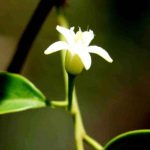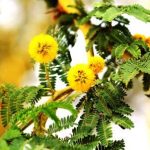TREE LIFE
July 1985
MASHONALAND CALENDAR
Saturday July 6th: Botanic Garden Walk at 1100 hours. Park in the car park
Saturday July 13th: Gill Masterson will be leading a small group through a patch of trees close to Harare. Would anyone wishing to attend please contact her well in advance to finalize arrangements, Harare 303455.
Sunday July 21st: Outing to Strathmore Farm, Ruwa, the home of John and Jill Marr Levin. An exciting woodland kopje with enormous granite boulders and a spectacular view of the Nora Valley. On the recce the fiery Hymenodictyon were a spectacular sight. I will not spoil the other rewarding finds, but only mention that there was one mystery species which we have not seen on a tree outing close to Harare for a long time here it grows in profusion.
Friday – Monday/Tuesday 9th – 12th/13th August: We now assume unconfirmed means unable to attend. We would sincerely like to remain away an extra day and return on Tuesday instead of Monday. We cannot find out whether Tuesday will be declared a public holiday or not, so it might entail taking a day’s leave. It should not cost more than $10 extra per person. If there is any objection to this proposal please contact either Phil, myself or Meg – Urgently.
AYRSHIRE CALENDAR
Sunday July 28th: Steve Steward has kindly offered to take us to Ferny Glen on Bandarlog Farm, where trees attain a height of up to 60 meters due to the presence of a spring. Depart from Ayrshire Rural Council at 0930. If any Harare members would like to share transport in order to join this exciting trip, possibly they could liaise with Phil or Kim at Harare 8871413.
MATABELELAND CALENDAR AND NOTES
Sunday July 7th: Our next meeting will be in the area of the Moth Shrine in the Matopos. It will be advisable to bring lunch. Meet first at Retreat at 0830hours.
Our last Meeting was on Sunday June 2nd at Hillside Dams at the Moffat Avenue end East of the Dams. It was a bit different from our usual Meetings, in that we had a most excellent Quiz, prepared by the Archers. Apart from the fall of the leaves, and the dryness of those remaining, it was not particularly difficult but it certainly exposed a good deal of ignorance and confusion. Altogether a useful and entertaining exercise, thanks to the good work of Geoff and Ruth.
SABLE FARM CHEGUTU JUNE 23RD 1995
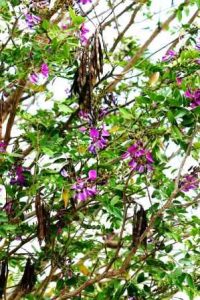
Mundulea sericea. Photo: Bart Wursten. Source: Flora of Zimbabwe
Although we met at Sable Park Farm, home of John and Bridget Eastwood, I believe that we joined the Mupfure, Umfuli, River on the farm next door. This part of the river is a little further downstream and on the other bank from the area we were in when we visited Roger Green at Ijapo estate. It is just as lovely, with sweeping rocks, interspersed with huge broken boulders and areas of water worn pebbles, including jasper and carnelian agates. The trees are just as fascinating too. At this time of the year we had the bonus of the brilliant colours in the leaves of Flacourtia indica, Combretum fragrans and C. molle and Mundulea sericea to mention a few. Also turning pinkish, the first thing that caught my eye was a mystery combretum. There were slender trees with very velvets composite leaves and a conspicuous conical buds in the axils of the leaves. We then found a similar specimen with smooth leaves but, bearing the tell tale little 4 winged pods with a distinct apical peg, which told us this of course was Pteleopsis anisoptera. Although it was only when we found the fruit on a velvety leaved specimen that I was really convinced. The genus Pteleopsis is a member of the COMBRETACEAE family and other species we get in this country is P. myrtifolia and having looked up “Flora Zambesiaca” I find that they are remarkable similar and where 10 differences are noted; all quoting features and saying either ‘probably’ or ‘almost certainly’, P. myrtifolia. But, and I quote “If the specimen shows considerable variability in some of the mentioned features and a puzzling mixture of characters, it is probably a hybrid”. It appears that they can be confused in the northern part of the country but in the South Eastern areas if we are lucky enough to find a Pteleopsis it will probably be P. myrtifolia.
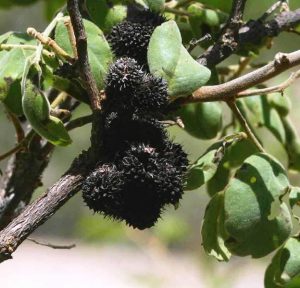
Dalbergia nitidula. Photo: Bart Wursten. Source: Flora of Zimbabwe
We looked at Dalbergia melanoxylon with its round leaflets and pale, flaking bark and Dalbergia nitidula with its gals like little hedgehogs which said “Hello, I occur on D. nitidula and help you identify the tree”. We spent sometime pulling flakes of bark off Crossopteryx febrifuga, of which there were many, looking for crystals and were eventually rewarded, perhaps the sun coming out helped. The bark is reputed to contain an alkaloid which is poisonous. It has been used in trial by ordeal ceremonies. Whether the crystals are the alkaloids or not is not clear from the literature.
Needless to say the Commiphoras had shed their leaves. Of the first one there was no doubt as it had distinct angular stems, leading to the positive identification of C. mollis. When I declared that the next one was the same I was quite rightly challenged and a look on the ground provided the characteristic shape of the trifoliate dried leaflets of C. mossabicensis. In view of their height perhaps I can be forgiven for automatically assigning them to the bigger species. Several of the Commiphoras were in fruit and we were able to split one and see the red pseudaril clasping the fruit.
Having decided to call it a day and head back to lunch and that we would only stop for something really exciting we found an ant hill with Strychnos potatorum quite ordinary but interesting as we had seen several S. spinosa and many of the S. innocua/madagascariensis complex. According to the distribution map they should have been S. madagascariensis but as they had dullish leaves with conspicuous net veining and bark that was inclined to be powdery and rub off on the hand they were probably S. innocua. Apparently S. madagascariensis has dwarf branchlets that resemble spines and while we did not look for those there were several comments that these trees had no spines. To return to our ant hill there was a clump of Canthium frangula with its opposite decussate spines and pairs of leaves on dwarf scaly branchlets. The stems were 6-10cm in diameter and the trees were 2-3m high. There was also Boscia angustifolia with its hard spine tipped leaves and B. salicifolia with its long drooping leaves, both displaying the very pale prominent midrib characteristic of the family.
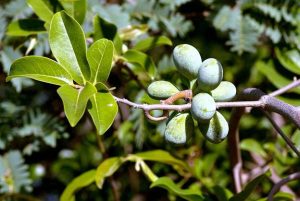
Artabotrys brachypetalus. Photo: Bart Wursten. Source: Flora of Zimbabwe
After lunch we wandered in the opposite direction and one of the highlights of the afternoon was Artabotrys brachypetalus with its little characteristic hooked stalks or peduncles and many fruit like galls They really are very fruit like but are hard and fibrous and not borne on the end of the hooks.
Also very worthy of mention were the two Sterculias. S. africana we saw first, leafless but the dried leaves were on the ground and there was one pod still on the tree. Then a little further along there were both S. africana and S. quinqueloba together, also bare and every one commented on the size of the five pointed leaf of S. quinqueloba. Unfortunately the pods were too high up for us to examine but were obviously very different from the very large pod of S. africana. I was not very good about marking up my card but I did tick 68 species, all fascinating, but it is unfortunately impossible to include them all here.
Thank you Chegutu members for inviting us to a memorable spot for a memorable day.
-Meg Coates Palgrave
BOTANIC GARDEN WALK 1ST JUNE 1985
Having completed the rest of the families in the order Malvales last month STERCULIACEAE, BOMBACACEAE and MALVACEAE, we began one of the most difficult of our indigenous families, the TILIACEAE, represented by the genus Grewia. Tom Muller guided us around the nineteen species he has growing in the Gardens. We were accompanied by Dr Jacobs from the University of Zimbabwe who worked on the TILIACEAE for the Flora of East Africa, although he wisely avoided Grewia and concentrated on the many other genera, none of which develop into trees in Zimbabwe.
The family TILIACEAE is named after the linden or lime tree, Tilia species, of the northern hemisphere.
The TILIACEAE have alternate leaves often arranged in two rows or ranks along the branch. The leaf is also often asymmetric with a lop sided bulge on the side away from the branch. As with the other families in the Malvales, the TILIACEAE leaves have three or more veins radiating out from the base. This similarity was most marked in Grewia villosa where the leaves closely resemble those of Dombeya rotundifolia, STERCULIACEAE. Dr. Jacobs recalls this species from India where it was first collected. The families in the Malvales are characterized by a mucilaginous slime, as anyone who has cooked okra will agree. Okra is the pod of Hibiscus esculentus, MALVACEAE. In order to illustrate the MALVACEAE flower I once handed students Abutilon, Chinese lantern, flowers to dissect, but having hurriedly dumped the blooms in a pail of water before lunch, they emerged a phlegmatic ooze. The description snot apple for Azanza, MALVACEAE, is most appropriate, but perhaps then Grewia avallana, TILIACEAE, should be called the snot berry. Despite this texture all Grewia fruit are edible and are a refreshing snack in the bush.
Meg and I have been playing with Grewia since the walk, revisiting and reworking the specimens in the garden and resulting in the birth of the attached notes grateful thanks to Meg and her photocopier. We must emphasize that this worksheet is only a guide based on the walk, we are not familiar with a number of the species, and remember that plants are often slightly different when grown in captivity. The arrangement into four groups or taxa follows Flora Zambesiaca. We find it proves most helpful. The term taxon I slipped into a previous write up without explaining. It simply means a group, any group. It can be used to refer to a group of plants which belong to the same family or the same order, or, as in this case, to four groups within the genus Grewia.
We discovered that where the leaf is said to be symmetrical (taxa 1, 3 and 4), it really means “only very slightly asymmetric”. In addition the number of lobes on the fruit is characteristic, but we learned that species in taxa 2, 3 and 4 often abort a berry or three, ending up with single berries. So specimens need to be checked thoroughly, except in the case of G. retinervis which are distinctly tear shaped.
Because this walk is g0ing to take longer than a month to digest here are a few cryptic markers to help relocate the specimens in the gardens: Tom does not have G. gracillima, G. decemovulata, G. subspathulata, which may not exist as a species anyhow, G. microcarpa, G. praecox and G. herbaces. I am sure he would appreciate seed of these species for the collection. In the S.E. Lowveld section G. retinervis, G. bicola, G. flava and G .stolzii are between the Sideroxylon and Gyrocarpus. G. lepidopetala is on the Spirostachys lawn. The seed of the G. sulcata beneath the Strophanthus kombe was collected by Gill Masterson. G. hornbyi, G. hexamita, G. avellena and G. villosa are spread between this Strophanthus and St. George’s fence. The large G. inaequilatera lies between this Strophanthus and G. caffra which flanks the largest baobab. G. tenax and another G. bicolor and near Sterculia rogersii. G. flavescens grows at the car park and G. occidentalis is between the pond and the herbarium while G. pachycalyx hides beyond the dyke Ozoroa in the woodland section. G. micrantha and G. schinzii grow just off the Ficus bubu lawn.
Despite all our efforts we were still foxed by the Grewia on Cupar Farm on the 16th. The small specimen with single berries was G. decemovulata which we learned may develop square stems but remains as a multi stemmed knee high shrub. The second specimen on ant hills rather blew my confidence in taxonomy – it turned out to be G. flavescens var. clukondae and if you think it bears any resemblance to the usual G. flavescens var. flavescens you are wrong. The clukondae has large circular leaves and less square stems. The fruit is in pairs and much larger than the var. flavescens. Strangely enough both varieties grew on the same anthills and we failed to notice any intermediates. From all of this we can only draw one conclusion, Gonarezhou must be Grewia nightmare.
Once again, thank you Tom, the living herbarium is such an aid to understanding.
-Kim ST.J. Damsra
SUNDAY 16TH JUNE 1985 : OUTING TO CUPAR FARM, BEATRICE
This month’s outing was to Cupar Farm in the Beatrice District, by courtesy of Dudley Steele and his family. The trip was somewhat a surprise for many because a bus arrived most unexpectedly due to a mix up, but we decided after all to take advantage of the bus.
The trip included an impromptu stop alongside a sizeable Ficus sycamores. The nearer side had been trimmed giving a “cut away” view of the interior of the canopy. We also admired solid stands firstly of Protea guaquedi, then Monotes glaber and thirdly of Terminalia sericea in delicate shades of dove grey.
Having stretched our legs walking from the bus to the tree venue, we got on with some serious tree spotting. A Rhus tenuinervis owed its colour not to flowers, but to the ripe orange fruit, typically flattened and square like cushions but small, 5mm, in size.
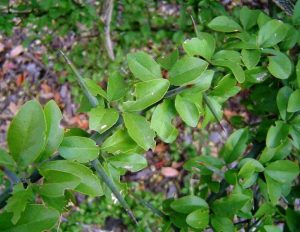
Balanites aeagyptica. Photo: Bart Wursten. Source: Flora of Zimbabwe
We congregated at the edge of an anthill and solved the problem of a thorny shrub with paired leaflets. This was Balanites aeagyptica which we last saw around Chegutu. This is regarded as something of an intruder from lower altitudes and is loosely associated with mopane, Colophospermum mopane, of which we also saw one or two specimens on our way to the farm.
Much learned discussion followed then, and throughout the day, on the subject of Grewia. Having missed the Botanic Garden Walk on the subject, I was blissfully ignorant, and leave the intricacies to Kim and Meg.
Unusually large numbers and sizes of Ehretia obtusifolia, E. amoena, were found on the anthills. Dick Petheram detected a Schotia brachypetala whose denouement resulted from its conspicuously winged rachis. Heavy serrations on the small elongate leaves of Cassine transvaalensis were contrasted later with the rounder leaves of Cassine aethiopica which were less serrate. The latter were especially notable for the bright lipstick red, pea sized fruit which the usually vigilant birds had evidently overlooked. Perhaps is was a pity that our Aloe Society siblings were not with us this month, for amongst a scattering of rocks was a wall to wall display of Aloe chabaudii in profuse flower. This species may be trite to Aloe folks but I think even they would have been moved to oohs and aahs as much as we were.
The fat “finger tips” on the ends of the branches of the Lannea discolor were the keys to this leafless riddle. In amongst these rocks Hexalobus monopetalus were unusually common, growing here as nothing more than a shrub but distinctive from its ANNONACEOUS growth style – the leaves held out in a flat horizontal “hand”. Your humble narrator failed to notice the Bridelia cathartica which, on good authority, were fruiting heavily in the area and so was unable to comment other than saying, second hand, that they were marble sized, apple green, and slightly 3 lobed as is common in the EUPHORBIACEAE.
Scouting further afield yielded a number of other finds; the leafless Elephantorrhiza goetzei was given away by the presence of the rims of the pods which had long since fallen away. Acacia rehmanniana was locally common and is distinguishable from the other Acacia with straight thorns and reddish bark namely A. karroo, as a result of the very minute leaflets. These one will fail to discern with the naked eye if one struggles to read the Herald without one’s glasses.
Three members of the RUBIACEAE family were seen all of which had the opposite leaves and an inter-petiolar stipule, but were in other respects very different. Catunaregam spinosa has paired spines, with each pair arranged at 90o to the one above and below it. With no spines, but with slightly furry leaves, was Vangueria infausta showing to good advantage the gall/parasite/disease, which makes it so distinctive from Vangueriopsis. The third species was very different sporting smooth, glossy and droopy leaves giving it a willowy appearance; Tarenna neurophylla for those who might not have guessed. Ochna pulchra lived up to its nick-name, the “mermaid tree” by covering its nether regions with rough scaly bark which flaked away towards the “torso” to reveal its sensuously smooth skin beneath the scales. Once one is aware of this feature the tree is unforgettable.
Speaking of Ochna, who could have failed to have noticed the small too high flowers of Ochna macrocalyx scattered about on the woodland floor? This diminutive species fails to attain tree status, producing a flower with separate ovaries in the middle in a cup of large red sepals which persists as the fruits ripen to black. One of our guests, Sue Worsley, who worked on Hwange vegetation reports seeing the same dwarfism in O. pulchra. This surprised me, but she assured me that the flowers are identical.
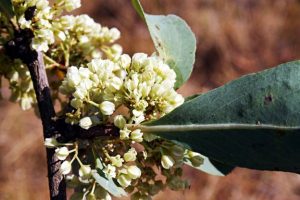
Maytenus senegalensis. Photo: Mark Hyde. Source: Flora of Zimbabwe
Before leaving off from the morning’s perambulations, it is worth making mention of the Maytenus senegalensis which for once confirmed the common epithet of “confetti bush”. As one knocked against a branch a shower of confetti from the falling white petals cascaded down.
After lunch the party re-embussed to be carried to the point from which our party launched its expedition in search of the Zanthoxylum reputed to be the denizen of another termitarium. It was worth the journey as the tree was a good sized specimen with a number of boles replete with thorny bosses scaling the trunks. Inspection of the leaves against the sunlight disclosed a peppering of pellucid yellow gland dots. Crushing the leaves released the familiar lemon smell which put this tree squarely with the citrus family RUTACEAE. The scattered dots meant that this was Zanthoxylum chalybeum rather than Z. capensis which we saw recently at Henry Hallam Dam and which is distinguished by having its dots around the edge of each leaflet.
Across a ploughed land was a further anthill which boasted a large Pappea capensis, during the morning we had noted how the leaves of small trees are very serrated and unpleasant to feel, a phenomenon thought to discourage browsers. This specimen was without serrations on its high boughs. It was in full fruit, and the height of the branches did not deter some of our ladies from going to great lengths to recover the pea sized fruit splitting to reveal the luscious semi-translucent fruit within. The resemblance to a ripe litchi fruit, except for the size and colour, is more than coincidental as both Pappea and the Litchi are of the SAPINDAVEAE family.
The journey home was interrupted by a lightning stop to compare a Zanthoxylum seen on an earlier date. Excitement was short lived though, for the scattered dots proved this to be but another Z. chalybeum.
We record our thanks to the Steel’s for allowing us the privilege of enjoying their vegetation.
-J.P. Haxen
ROOTNOTE : I once threw out the fact that Tabernaemontana was not named after a table mountain but rather in honour of a botanist, Tabernaemontanus. After frantically failing to find the source of this useless bit of information, I mentioned it to Brain Best who discovered the following: Many early botanists preferred to identify with the Latin names they dealt out to plants and altered their own names. The famous Linnaeus was really born Karn von Linne. Tabernaemontanus is the Latinized version of Jakolo Theodor von Beergzabern, personal physician to the Count of Palatine at Heidelberg, and the author of a famous herbal, Neuw Kreutebuch.
-KIM DAMSTRA Acting Chairman.


